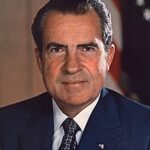The Environmental Protection Agency Decision
President Nixon established the Environmental Protection Agency through Reorganization Plan No. 3 on December 2, 1970. This decisive action consolidated environmental responsibilities scattered across fifteen federal agencies. The decision came amid rising public concern about pollution and environmental degradation. 📊 Opinion polls showed 70% of Americans considered environmental protection a national priority by 1970.
Political Context and Timing
The first Earth Day on April 22, 1970, drew 20 million participants nationwide. Rachel Carson’s “Silent Spring” had awakened environmental consciousness throughout the 1960s. Industrial pollution disasters like the Cuyahoga River fire in 1969 demanded federal action. Nixon recognized the political necessity of addressing environmental concerns. ⚠️ Critics argued the move was purely political positioning for the 1972 election.
Implementation Strategy
The Environmental Protection Agency began operations with 5,800 employees and a $1.4 billion budget. William Ruckelshaus became the first EPA Administrator on December 4, 1970. The agency immediately inherited authority over air and water quality programs. Nixon’s plan required Congressional approval within 60 days to take effect.
Impact:
Immediate Environmental Achievements
The Environmental Protection Agency quickly established nationwide pollution standards and enforcement mechanisms. Within two years, the EPA implemented the Clean Air Act of 1970 and Clean Water Act of 1972. 🌍 Air quality monitoring stations increased from 59 to over 4,000 nationwide by 1975. Lead levels in ambient air dropped by 94% between 1970 and 1990. The agency banned DDT pesticide use in 1972, protecting wildlife populations.
Economic and Industrial Transformation
Manufacturing industries invested billions in pollution control technology to meet EPA standards. The catalytic converter became mandatory for automobiles starting in 1975. 💰 Environmental compliance costs reached $26 billion annually by 1979, creating new green technology sectors. Steel, chemical, and automotive industries modernized production processes. Economic studies later showed environmental regulations generated $2 trillion in benefits through 2010.
Long-term Environmental Legacy
The Environmental Protection Agency established the framework for modern environmental protection in America. Superfund legislation in 1980 addressed toxic waste cleanup at contaminated sites. The agency’s regulatory authority expanded to include pesticides, chemicals, and nuclear waste. 🔥 Political battles over EPA authority continue, but the agency’s core mission remains unchanged. Environmental protection became permanently embedded in federal policy structure.
